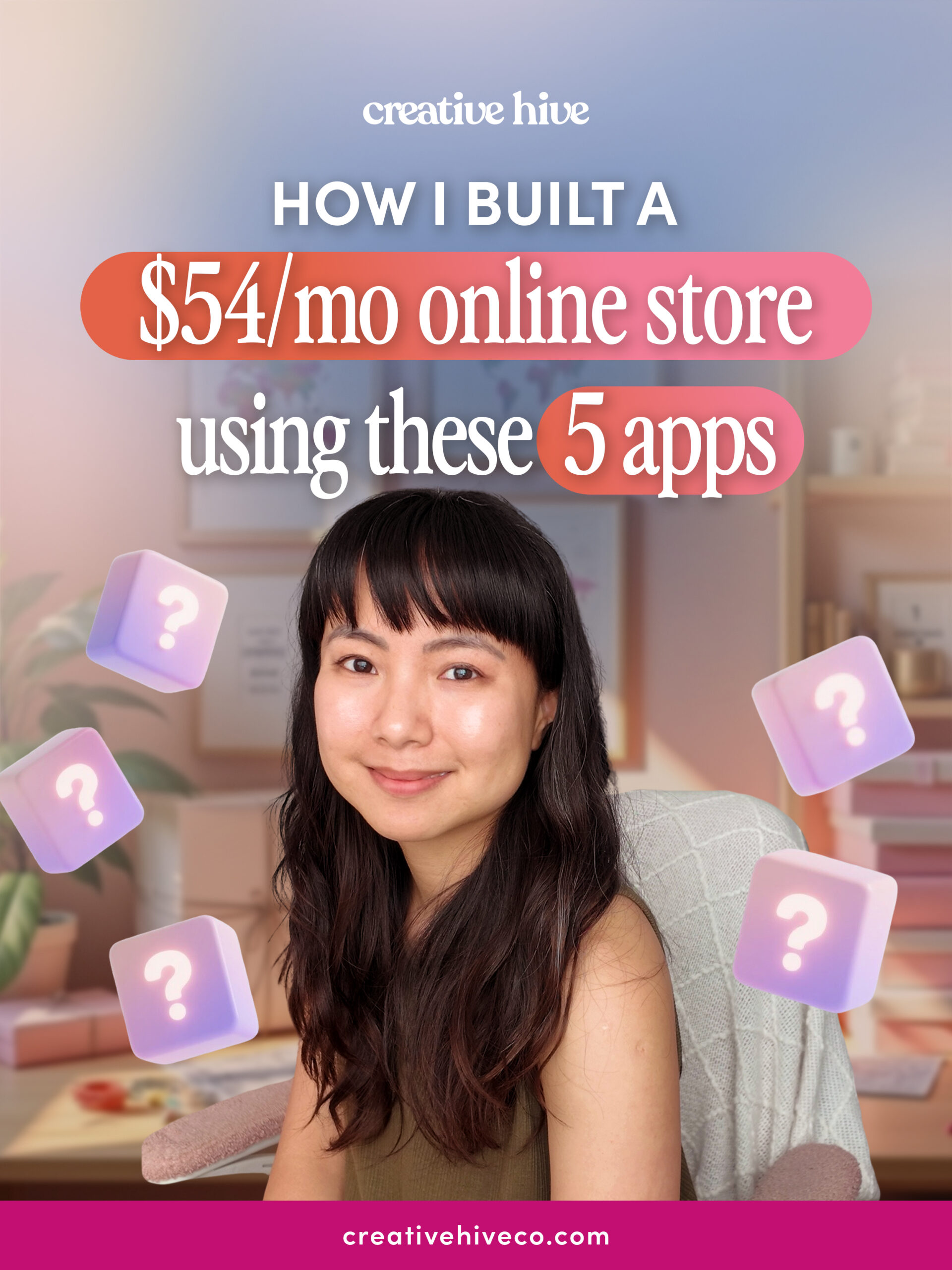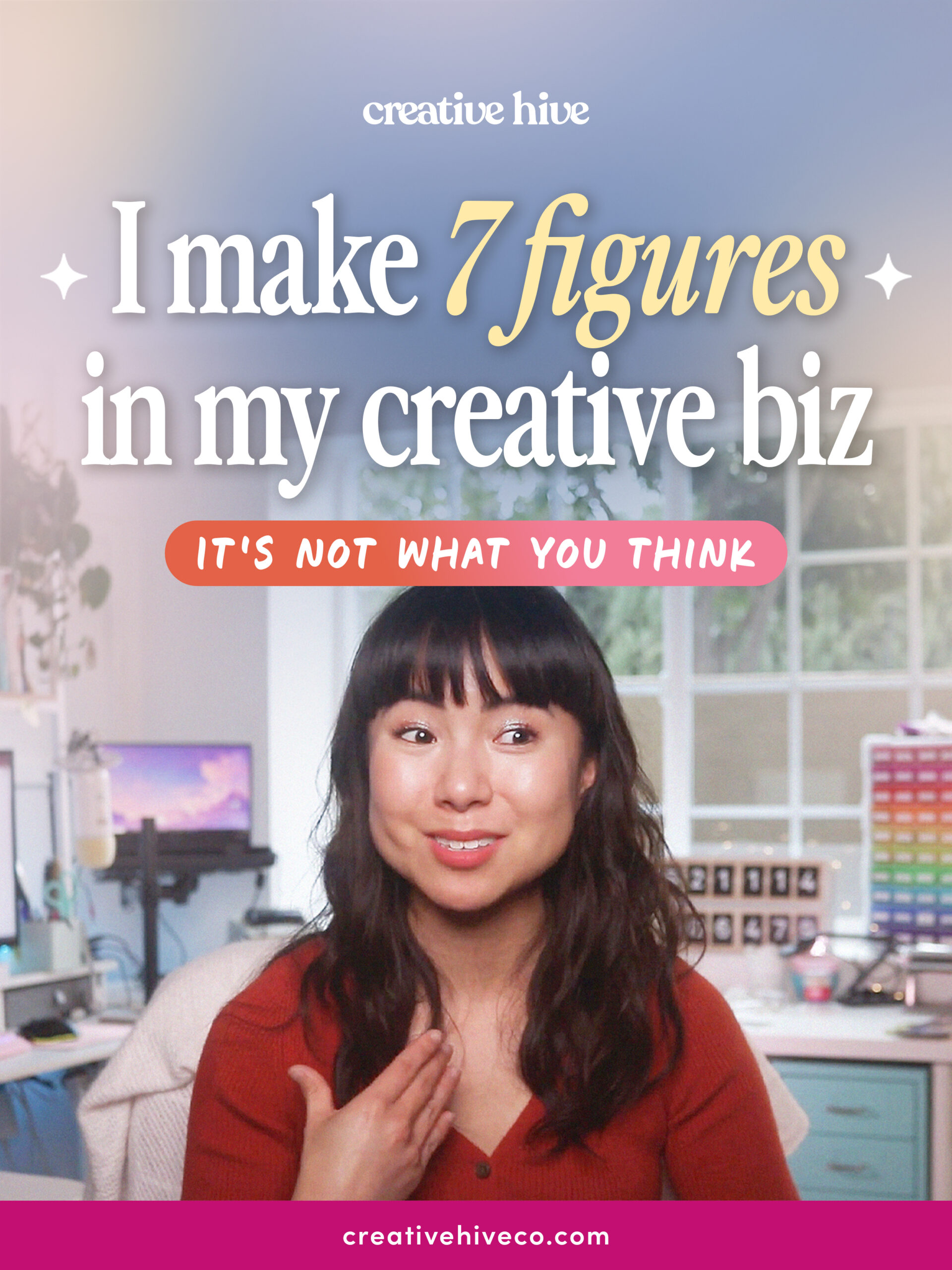How I built a $54/mo online art store using these 5 apps
I want to help you build a sustainable, profitable handmade business that makes you consistent income and sales. I only ever teach or recommend marketing, social media, pricing, production and branding tips that I’ve personally used successfully in my own 7-figure handmade businesses.
I'm Mei, from Los Angeles!
Read More
Popular Posts You'll Love
Looking for something?
Categories
starting a business
get more traffic
running a business
make more sales
branding
growing a business
mindset & productivity
podcasts
pricing & money
product photography
reviews
selling on etsy
selling on amazon
social media
selling wholesale
- Facebook0
- Twitter0
- Pinterest0
- 0shares
I made $54,000 a month selling personalized art and I did it with only 5 Apps.
Most people think you need a dozen different apps, a huge team, and endless hours to scale a personalized art business.
Others assume it’s not even possible to automate something customized. But I’m here to prove otherwise.
We’ve built a streamlined, highly profitable art business using just 5 apps and in this blog, I’ll walk you through each one
Everything is so systematized that my husband, Peter, who now runs the store, spends less than 10 hours a week on it.
That time goes mostly into strategy, paying staff, answering the occasional team question, and tweaking or designing new products.
How? We nailed down 5 apps that do all the heavy lifting.
The best part, these apps are totally accessible. You can install them today. Most are free to start using, and you don’t need a big budget to get going.
These 5 tools helped us automate the most time-consuming, stress-inducing parts of our business, the things that used to eat up 90% of our week.
So if you’re an artist or creative entrepreneur who’s stuck manually managing orders and artwork, and you’re ready to work smarter (not harder), keep reading so you can implement this same system starting today.

The #1 mistake artists make that keeps their business stuck
Before I drop the 5 apps that helped us scale our personalized art store to $54,000/month, I need to tell you something most creative entrepreneurs need to hear:
Your business will only grow as far as your systems.
I’ve seen talented artists stay stuck at hobby-level income not because they weren’t good enough, but because their backend was a total mess.
You’re selling on Etsy, maybe also on Shopify. You’ve got customers emailing you, DMing you on Etsy, messaging through your website’s contact form, it’s everywhere.
Now add in the stress of trying to keep track of revisions, delivery dates, and approvals.
If you’re tracking orders with spreadsheets, sticky notes, or let’s be real, just trying to keep everything in your head, you’re begging for chaos.
You start mixing up orders, delivering late, forgetting customer changes and when that happens, those customers don’t just get upset.
They don’t come back, trust is lost, and your reputation takes a serious hit.
All of the art we create for our customers is fully personalized, which means most orders require multiple revisions depending on the individual.
And honestly, it becomes a massive headache to keep everything running smoothly at scale without some kind of technology in place.
Trying to remember what one customer asked to change versus another, and keeping track of which order belongs to who, gets overwhelming fast especially when you’re juggling 10 custom pieces at once.
Without a system, it’s nearly impossible to stay organized.
APP #1: AIRTABLE
This is where Airtable comes in and basically saves our sanity.
Think of Airtable as mission control for your entire art business.
If you’re new to Airtable, it’s like a spreadsheet but also a database, so it’s more powerful than a simple Google Sheet or Excel file.
Every single order from our Shopify store and Etsy shop gets automatically pulled into Airtable.
That means no more manual data entry, no more copying and pasting order info from one place to another.
Once it’s in Airtable, we view everything through a Kanban board, think Trello-style columns that show where every order is in our production pipeline.
We can see at a glance which orders need art created, which pieces are currently being worked on, what’s waiting for customer revisions, what’s ready to print, and what’s already been delivered, and so on.
This visual setup means we can instantly see what’s going on. If an order’s late? We know.
If a customer is ghosting us on revisions? We’ve got a system to gently nudge them via email, text, even a phone call if needed.
Tens of thousands of orders have touched this system, so it’s really been stress tested and proven and works well for us.
Our entire team can see the same dashboard. Our artists know exactly what to work on next.
Our one customer service team can give customers real-time updates.
And Peter and I? We don’t have to micromanage a single thing.
It’s what lets us run a lean, efficient team across two platforms (Shopify + Etsy) without anything slipping through the cracks.
Without this system, we’d never be able to delegate specific orders to different artists without any confusion.
“Okay… But this sounds kinda advanced?”
I get it, you might be thinking, this sounds amazing, but you’re just trying to hit your first $1,000 month. You’re nowhere near ready for a whole Airtable setup.
If that’s you, I made something for you.
I have a free workshop that will walk you through my step-by-step roadmap for how you can start your own business without relying on Etsy, social media and get consistent $1000 months in sales and beyond.
Click on the link here to learn how to that: https://tinyurl.com/ytb9amur
APP #2: PRINTFUL
While Airtable helps us stay organized with order tracking, that’s just the beginning.
The real challenge? Fulfilling dozens of personalized art orders without turning our home into a warehouse.
No stacks of printer paper, no shipping supplies piled in the kitchen and no $500 printer humming in the living room.
Here’s what most people don’t understand about building a profitable online art business that pays you a full-time income: Inventory will kill your cash flow, and storage will eat your profits if you’re not careful.
Most artists I coach make the mistake of spending way too much money on supplies, materials and expensive equipment and then struggle to make any sales.
There’s a much smarter way to do this if you’re open to it!
Let’s talk about Print-on-Demand (POD).
If you’re not familiar, POD means your product only gets made after a customer places an order.
No inventory, no storage and no shipping supplies taking over your studio or garage.
Now there are dozens of print-on-demand companies out there, but we use Printful. We’ve stuck with them for three specific reasons:
1. Their quality is consistently good enough for our customers.
As artists, we obsess over quality. We want gallery-grade prints, the perfect paper texture, the richest ink tones. But here’s the thing:
Your customer probably isn’t an artist.
They’re not examining the grain structure under a magnifying glass. They want a piece that looks amazing on their wall and feels like a good value.
Printful hits that sweet spot: good quality that customers love, without the premium price that kills your profit.
Artists usually go for museum-grade everything, which leads to two problems:
- You either price your art so high no one buys it…
- Or you barely profit, even when they do.
Be careful about choosing the priciest option just because it seems like the best.
2. Their pricing leaves room for profit
We pay Printful about a third of the order value that comes in from sales.
So if an order was $100, we’d pay Printful about $33 for the cost of the print, frame, packing and shipping the order directly to the customer.
3. Seamless integration with Shopify & Etsy
This is where things get magical.
When a customer orders from our Shopify or Etsy store, the system does all the heavy lifting.
Our artist creates the custom piece, the customer approves it, and Printful takes it from there: printing, packing, and shipping.
So no spreadsheets, no manual uploading and no missed orders!
If you’ve ever done POD manually, you know how tedious it can get. Printful’s automation frees up time so we can focus on what we actually want to do: making art, connecting with customers, and growing the business.
If you want to start your POD business using Printful without inventory, click here: https://tinyurl.com/hdkmxxd3
But here’s the catch: Communication Is Everything
Even with POD, most art businesses still struggle. Why? Because they forget one crucial piece: team communication.
When you’re creating custom or personalized art, your customer service team, your artists, and even your customers all need to stay on the same page.
Without a simple system to keep everyone aligned, things can quickly fall apart.
Customers get frustrated, artists feel overwhelmed, and orders start slipping through the cracks.
That’s where the right communication tool makes all the difference.

APP #3: SLACK
This is why we use Slack as our central communication hub.
When you’re creating personalized art, there are constantly moving pieces.
Customer service receives specific requests from customers, artists need clarification on designs, revisions need to be communicated back and forth, and if any of this happens through email or text messages, important details can get lost.
Using an app like Slack helps prevent communication breakdowns that can quietly kill your custom art business.
One miscommunicated detail can turn a happy customer into a refund request and a bad review.
Here’s how we’ve set up Slack to avoid those painful (and costly) communication breakdowns:
Each order has its own dedicated channel.
We have specific channels set up for each order, so any order notes or customer requests are automatically fed into that channel as messages.
This way, the artist assigned to the order can see all communication between the customer and customer service after the order is placed.
If the artist is confused or needs clarification, they can ask directly in that order’s channel.
Customer service then sees the message, relays it to the customer, and shares the response,
The beauty of Slack is that everything is searchable and nothing gets lost. If we need to reference a conversation about a specific order from three weeks ago, we can find it in seconds.
Plus, since everyone can see the relevant conversations, if someone’s out sick or busy, anyone else on the team can jump in and help without missing any context which has been incredibly helpful.
Once our artists finish a custom piece, sharing and storing the finished artwork professionally is just as important as creating it.
APP #4: DROPBOX
This is something most people don’t think about when starting a custom art business.
How do you professionally share artwork with customers and keep everything organized when you’re creating hundreds of unique pieces?
When you’re doing personalized art, you can’t just email large image files back and forth.
Email attachments have size limits, files get buried in email chains, and there’s no good way to organize everything for future reference.
That’s exactly why Dropbox has become our go-to solution. It solves all of these problems for us.
Here’s our exact workflow:
- When an artist completes a piece, they upload the high-resolution files to a specific Dropbox folder organized by order number.
- Then, our customer service team steps in and shares low-resolution versions of the art with a watermark with the customer so they can view their artwork without downloading massive files.
- If the customer requests revisions, the artist simply uploads the updated version to the same folder.
- From there, customer service sends the revised files to the customer. Everything stays neat and organized, and we keep a permanent record of every revision and version we’ve ever created.
Over time, this also builds an incredible asset library.
Sometimes customers come back months later wanting to re-order the same design. Thanks to our system, we can find their original artwork right away.
Even better, we keep the layered Photoshop PSD files in the Dropbox folder, so if a different artist takes over that particular order, they can pick up right where the previous artist left off.
Now, all of these apps are powerful on their own, but the real magic happens when they all work together automatically.
And that’s where most businesses get stuck. They have great tools, but everything still requires manual work to connect them and get them talking to each other.
If you’re scaling a custom art business, solving this backend puzzle early can save you countless hours and headaches down the road.
Once you have the right tools in place, the next step is making them work together seamlessly, and that’s where automation comes in.
APP #5: MAKE
Here’s what separates a $5,000 per month art business from a $54,000 per month art business: Automation.
Most creative business owners are so focused on creating that they never systematize the business side yet that’s exactly what opens the door to taking on way more orders without burning out.
Our secret weapon? A tool called Make.com.
It’s like Zapier, but it’s got more stuff, and honestly, it’s like having a digital assistant that never sleeps.
It connects all your apps so they can work together seamlessly. Think of it as the nervous system that makes your entire business run on autopilot.
Here’s an example of what you can set up for yourself: when a new order comes in on Shopify or Etsy, Make automatically creates a new record in our Airtable database with all the order details.
It then creates a Slack channel and a Dropbox folder for that specific order.
When an artist finishes the artwork, the automation moves their layered Photoshop file into that order’s Dropbox folder.
Once the customer approves their artwork, and because Printful integrates directly with Shopify, we can send the final files to Printful to start production.
The result is that orders flow through our system as smoothly as butter.
From the moment a customer clicks “buy” to the moment they receive their personalized art, our team only needs to touch each order about 3 to 4 times, instead of 15 to 20.
THE RESULTS & TRANSFORMATION
Let’s rewind for a second. Before we built this system, we were doing everything manually.
Every order was a new opportunity… to make a mistake.
Files got lost, deadlines slipped, and customer emails fell through the cracks. The entire process was so error-prone, we could feel our customers getting less happy with us.
Fast forward to today, and things look radically different.
Now, with these 5 apps working together, we can consistently make five to six figure sales a month especially around the holidays.
We haven’t needed to hire a massive team to do it. The apps handle the heavy lifting, so we can focus on what we do best: creating.
Personally, I find that all of this really helps improve the customer experience.
Our customers now receive faster response times because nothing falls through the cracks.
They receive their art proofs professionally, get accurate order updates because everyone can see the Airtable pipeline, and enjoy consistent quality because our processes are systematized.
We’re so on top of the ball!
Behind the scenes, the transformation has been just as powerful for our team. Airtable gives everyone clear priorities, Slack keeps communication clean and centralized.
Manual tasks? Gone.Our artists have more time, less stress, and way more creative energy to pour into their work.
These 5 apps have completely changed how we run this business, but the question I get all the time is how do I actually get customers in the first place without a huge social media following?
Here’s the truth, none of this matters if you don’t have any customers to begin with.
And this is where most artists get stuck. They think they need to be glued to Instagram or wait for a TikTok to go viral before they can make money online. But that’s completely backwards.
You don’t need a huge social following to build a thriving, profitable art business.
In fact, I built multiple 7-figure handmade businesses without chasing likes, followers, or viral videos.
I break down exactly how to get your first paying customers in this blog: https://tinyurl.com/mrxbaxbs
If you’re a creative entrepreneur dreaming of turning your art into a full-time income, don’t just focus on creating beautiful work, build the backend to match.
When you combine creative talent with smart automation, you don’t just survive, you thrive.
You create a business that runs smoother, delights customers, and grows without eating up every hour of your day.
So whether you’re just starting out or looking to scale, remember this:
The difference between $5K months and $54K months isn’t hustle, it’s systems.
Now go build yours.

Leave a Comment
Liked this article? Share it!
Unlock a Profitable Handmade Business
in Just 12 Weeks Without Using Etsy
or Social Media
FREE WORKSHOP
This workshop is for anyone who makes and sells a handmade or physical product, including jewelry designers, artists, paper designers, bath & body product makers and more!
What You'll Discover
The #1 mistake people make with Etsy & social media that causes shops to FLOP
The secret to making it with your handmade shop so it's no longer just a hobby
How to make sales in your handmade shop with ease so you can finally get to 6-figures
TAKE ME THERE
Your email address will not be published. Required fields are marked *
Leave a Reply Cancel reply
About
Blog
A Sale A Day
Student Login
Free Class
Contact
Terms
Become A Student
Watch On YouTube
Student Reviews
See My Handmade Shop!


woww, so surprise
Amazing how you built a $54k/month art store using just five apps! I love the focus on automation and smart systems. Which app saved you the most time or boosted sales the most?
bitlife is a testament to the power of choice and consequence, offering players a unique and engaging life simulation experience that reflects the complexities of real life and the myriad paths one can take in their journey.
yeah I love this
It’s incredible how you used just five apps to create an art store that makes $54,000 a month! The emphasis on automation and intelligent systems is fantastic. Which software increased sales or saved you the most time?
very open and very clear clarification. It contains truly facts. Your website is very valuable. Harris County Texas Toll Roads Authority
This sounds super interesting! Making $54,000 a month with only 5 apps for personalized art is seriously impressive.
It’s inspiring to hear how you’ve streamlined your art business using just five apps! Your experience highlights the importance of having an effective system in place. I can relate to the chaos of managing orders and revisions manually. This approach is particularly beneficial for creative entrepreneurs. By the way, if you or anyone is into sports too, they’re managing their own system with great success at Football Bros. Thanks for sharing your insights!